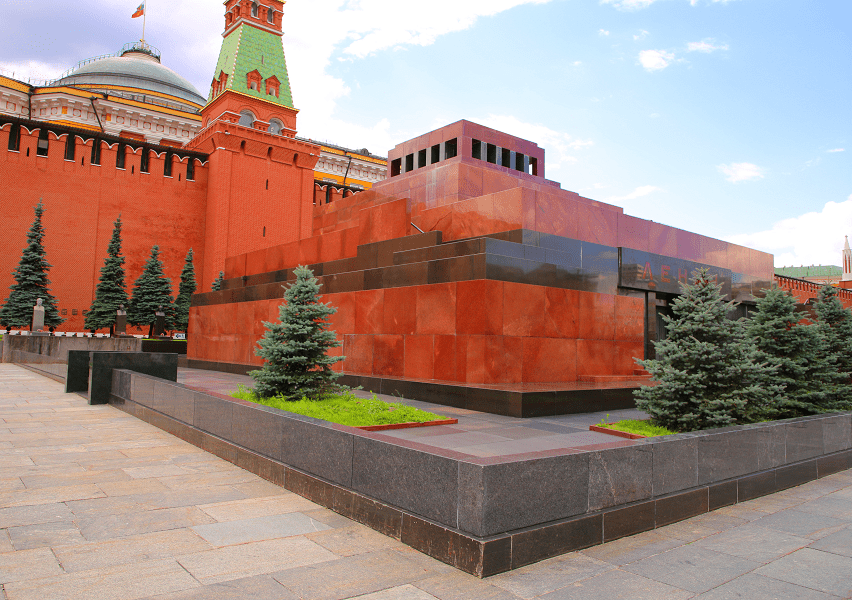The Mausoleum of Vladimir Ilyich Lenin (in 1953-1961 – the Mausoleum of Vladimir Ilyich Lenin and Joseph Vissarionovich Stalin) is a monument-tomb on Red Square near the Kremlin Wall in Moscow, where since 1924, the body of Vladimir Lenin has been preserved in a transparent sarcophagus.
The first wooden mausoleum was erected in January 1924 – immediately after the leader’s death, and the second wooden one – in May 1924. The stone mausoleum was finished by October 1930.
At the mausoleum, since 1924, there has been a laboratory for preserving the body of Lenin, in which the bodies of several well-known politicians from different countries were embalmed. From 1953 to 1961, the mausoleum housed a sarcophagus with the body of Joseph Stalin. On October 30, 1961, the XXII Congress of the CPSU decided that it was impossible to continue to find Stalin’s body in the mausoleum, after which it was buried in a necropolis near the Kremlin wall.
From 1989 to the present, there have been disputes over Lenin’s reburial and the mausoleum’s closure.
The mausoleum is the object of the Service of the commandant of the Moscow Kremlin.
The stone mausoleum was erected in 16 months – by October 1930. Compared to the wooden building, the new building was built three meters higher; the external volume increased 4.5 times – 5800 m³, and the internal volume was 12 times, up to 2400 m³. Its total weight was approximately 10,000 tons. As a result, the mausoleum occupied the highest point on Red Square.
Under the leadership of Isidor Frantsuz, during the construction, the mausoleum and the necropolis were brought to a single architectural design: the various tombstones and monuments were removed, individual and collective burials at the Nikolskaya and Spasskaya towers were united, the fence was redesigned and installed. In addition, guest stands for ten thousand seats were installed on both sides of the mausoleum.
The mausoleum contains a vestibule, a Funeral Hall, and two staircases. Opposite the entrance, a coat of arms of the USSR of the 1923 model was carved on a huge granite block. Two staircases lead down from the lobby. On the left staircase, three meters wide, visitors descend to the Funeral Hall. Exit the Funeral Hall to the right staircase that leads to Red Square.
Sarcophagi
Since 1933, for 11 years, fulfilling the strict requirements of doctors, the laboratory team has created dozens of versions of the sarcophagus. Its task was maintaining a constant temperature, so they began using filters on lighting fixtures that absorb thermal energy.
The disadvantage of the first sarcophagus was that reflections of visitors could be seen through the glass. To get rid of it in 1939, the All-Union Electrotechnical Institute began work on the creation of a new model of the sarcophagus. Alexei Shchusev and sculptor Boris Yakovlev led the project. Another problem was the light bulbs, which got very hot and had to be turned off periodically.
The new sarcophagus received the shape of an inverted trapezoid: such an angle of reflection was chosen that the glass became invisible to the viewer. In addition, mirror lamps and light-optical devices were placed in the upper slab of the sarcophagus for better illumination of the body. The sarcophagus was installed in the mausoleum at the end of the Great Patriotic War in 1945.
The scientific laboratory was engaged in observing the temperature regime and maintaining the necessary air humidity in the sarcophagus, whose employees monitored the condition of the skin, monitored the composition of special solutions for impregnation of the body, regularly photographed the body to fix and determine changes in the volume of the relief of the hands and face, examined body tissues for processes destruction and performed many other tasks.
On September 16, 1945, the mausoleum was opened to visitors after a thorough reconstruction. According to statistics, since this year, it has been visited by about a million people a year, on weekdays – 3-5 thousand people, and on weekends – from 9 to 15 thousand.
In 1990, the Lenin Mausoleum and the necropolis near the Kremlin Wall were included in the UNESCO World Cultural Heritage List. Since 1995 they have received the status of objects of the historical and cultural heritage of federal significance.
Working hours: Tue, Wed, Thu, Sat, Sun 10:00–13:00.
Address: Red Square, 9, Moscow.
Nearest metro stations: Okhotny Ryad, Teatralnaya, Revolution Square, Kitay-gorod.
Red square ensemble (full list):
Cathedral of the Kazan Icon of the Mother of God
Monument to Minin and Pozharsky
House of the Provincial Government
See also Architecture of Moscow, Palaces and most historic buildings of Moscow.













